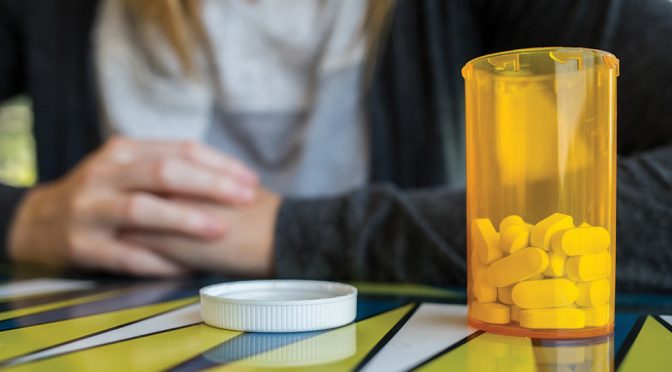Each day in the United States, 144 people die from opioids.
As if that’s not startling enough, an estimated 2 million Americans are addicted to prescription opioids, and more people die each year from overdoses than car crashes.
National leaders in 2017 declared America’s opioid epidemic a public-health emergency — a designation typically reserved for natural disasters
University of Missouri-Kansas City health professions faculty and staff are combatting the crisis on multiple fronts locally, regionally and nationally — all armed with research. Their work is an all-out 360-degree approach: from mining data to educating future health professionals and training current care providers to helping people and their families who are struggling with the highly addictive class of painkiller.
“It’s not just an urban problem or a rural problem, it’s an everywhere problem,” says Heather Lyons-Burney, clinical assistant professor at the UMKC School of Pharmacy. “One thing is not going to fix this problem. We have to attack it from different angles.”
Data Tells the Tale
The research of Maureen Knell, clinical associate professor in the School of Pharmacy, is being cited with greater frequency in the wake of the opioid crisis.
The New York Times, The Kansas City Star and Kansas Public Radio have featured Knell and longtime collaborator Rafia Rasu of the University of Kansas School of Pharmacy. For years, they’ve been analyzing data from about 690 million outpatient clinic visits by patients who suffer from chronic pain not related to cancer.
They’ve detected some surprising patterns. People 35 to 49 years old were more likely to get an opioid prescription than younger adults — and more likely to get one than those over 65.
“Maybe physicians have the assumption that they’re safer in middleaged patients,” Knell says.
Primary-care doctors were more likely to prescribe opioids than specialists, especially if they had a longstanding relationship with their patients.
Financial factors might be at play, with providers more likely to steer Medicaid patients toward inexpensive generic opioids for pain rather than alternatives like physical therapy or newer brand-name non-opioid painkillers, Knell found.
Linked to that, Knell and Rasu discovered discrepancies in opioid
prescribing that seemed to be more cultural than clinical. Poverty and chronic health conditions are higher in the South, which could explain the higher rates of opioid prescription there.
“As far as the patterns we saw, we found that opioid use was reported in 14.3 percent of the total patient visits,” Knell says.
The pair also found that Hispanic patients, regardless of where they lived, were 30 percent less likely to get an opioid prescription than their non-Hispanic counterparts.
They said that could be due to language barriers that make it more difficult for patients to describe their pain, making physicians feel less confident they will be able to communicate how to take the drugs safely. Or it could be that Hispanics have a higher tolerance for pain, which is consistent with other studies as well, Knell says.
So what are the key takeaways from these findings?
Knell says prescribers aren’t always following guidelines like those from the American Academy of Pain Medicine and the Centers for Disease Control and Prevention. A prescription has to be appropriately written, and they need to verify if a patient already has tried something else as a first-line therapy.
Also, Knell and Rasu hope to influence policymakers, public health officials and health care providers through their research.
Up next: Knell and Rasu want to analyze newer data. Their last study was based on data from 2000 to 2007, the most recent when they started.
Building Capacity for Action
One of the main reasons our nation has not been able to address the opioid epidemic is because we don’t have the workforce capacity to do so, says Laurie Krom, co-director of the Addiction Technology Transfer Center Network, called the ATTC for short.
For 20 years, UMKC has housed the national and regional ATTC coordinating offices. Their top mission: accelerate the implementation of promising addiction treatment and recovery practices and services. The topic of opioids dominates the ATTC’s news and upcoming events lists.
The ATTC is part of the Collaborative to Advance Health Services at the School of Nursing and Health Studies. To address the workforce problem, the Collaborative, in partnership with the American Academy of Addiction Psychiatry, was awarded an $8 million grant for two years from the Substance Abuse and Mental Health Services Administration to support primary-care providers in the prevention and treatment of opioid-use disorders.
The project is an unprecedented alliance of physician, nurse, allied healthcare and behavioral health organizations with broad national, regional and state networks and technical expertise in preventing, treating and supporting recovery from substance-use disorders.
“This money will go to provide training and assistance to build the capacity of physicians and counselors to provide treatment in evidencebased care,” says Krom, who also is an investigator on the grant, the work of which will benefit those needing treatment nationwide.
“Our hope is that it will have an impact on the people and communities who are suffering,” says Holly Hagle, co-director of the ATTC Network, UMKC assistant research professor and principal investigator on the grant.
In addition to Hagle and Krom, Patricia Stilen, director of the regional ATTC Network, also at the Collaborative to Advance Health Services at UMKC, is an investigator on the grant.
Those people suffering are close to home. In 2016, more than 900 people in Missouri died from overdosing on opioids. According to state data, one in every six deaths was opioid-related.
Krom says 419,000 people in Missouri have diagnosed substance abuse disorders. She says 17,000 of those people are children between 12 and 17 years old.
“Kansas City, St. Louis and southwest Missouri are really being impacted by the opioid epidemic,” she says.
Preventing Problems
When Heather Lyons-Burney first became a pharmacist two decades ago in Missouri, prescriptions for heavy-duty pain medication were only given for the worst suffering, for those who just underwent surgeries, who had cancer or who were in hospice care.
But then the tide turned.
Newer agents — opioids — with long-lasting pain relief would take care of those who suffered back and other types of ongoing pain. No need to worry about addiction, right?
Wrong.
People sought them for more than pain relief and soon pill mills — places where unethical doctors hand out prescription drugs like candy — sprouted up across the country.
The health-care industry cracked down on itself, and the tide has turned again.
“Providers are looking for other ways for patients to manage pain instead of narcotics,” she says. “Like physical therapy and chiropractic care, for example.”
As a pharmacist, Lyons-Burney has become involved with preventing opioid use on many levels in Missouri:
- Through leadership positions in the Missouri Pharmacy Association and the Ozark-area pharmacy community where she lives and works.
- Through county coalitions in Greene County in Springfield and Taney County in Branson.
- Through the choice not to carry controlled substances at Faith Community Health, the nonprofit clinic she helped establish.
- Through working with Generation Rx, a prescription drug misuse prevention program run by university student pharmacy chapters.
- Through teaching future pharmacists at UMKC. She’s based at the UMKC School of Pharmacy at Missouri State University in Springfield, but through broadcast classes, teaches students at the two other locations in Kansas City and Columbia.
This past summer, she has been researching how prevention efforts have worked through survey data.
“We have a responsibility to people to fight this problem and help people,” Lyons-Burney says. “We’re getting there.”

